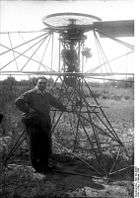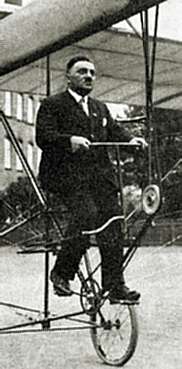Engelbert Zaschka
| Engelbert Zaschka | |
|---|---|
|
Engelbert Zaschka and his human-powered glider during 1934 | |
| Born |
September 1, 1895 Freiburg im Breisgau |
| Died |
June 26, 1955 (aged 59) Freiburg im Breisgau |
| Resting place | Freiburg im Breisgau |
| Residence | Germany |
| Nationality |
|
| Occupation | Engineer, Inventor |
| Known for | Helicopter, human-powered aircraft, automobile engineering |
| Title | Chief Engineer, Chief Designer, Inventor |
Engelbert Zaschka (September 1, 1895 in Freiburg im Breisgau, Germany – June 26, 1955 in Freiburg im Breisgau, Germany)[1][2] was a German chief engineer,[3] chief designer and inventor.[4]
Biography
Zaschka became one of the first German helicopter pioneers. His machine is a striking representative of the Rotationsflugzeug (Zaschka calls it "rotating airplane").[5] Chief Engineer Engelbert Zaschka pursued in 1929 in Berlin, the approach of the folding-Zaschka three-wheeler. This city car concept was aimed to be cost effective and space saving by the vehicle could be folded after use sparingly. In 1934 Engelbert Zaschka completed a large human-powered aircraft. He was an inventor who held numerous international patents as it related to the helicopter.
Engineering Activities
Zaschka Helicopter
.jpg)
In 1927[6] Engelbert Zaschka of Berlin built a helicopter, equipped with two rotors, in which a gyroscope was used to increase stability and serves as an energy accumulator for a gliding flight to make a landing. Gliding in this case means a straight descent. He wanted to develop an efficient propeller drive.[7] A swivelling propeller at the rear provided propulsion and rudder control. The machine was a combination of an autogyro and a helicopter. The principal advantage of the machine, Zaschka says, is in its ability to remain motionless in the air for any length of time and to descend in a vertical line, so that a landing may be accomplished on the flat roof of a large house. In appearance, the helicopter does not differ much from the ordinary monoplane, but the carrying wings revolve around the body.
Zaschka Human-Power Aircraft (1934)
.jpg)
In 1934[8] Engelbert Zaschka completed a large human-powered aircraft, the Zaschka Human-Power Aircraft. Zaschka constructed the large human-powered tractor monoplane with a narrow wing spanning about 66 feet (20 metres). On 11 July 1934 he flew his large human-powered aircraft, the Zaschka Human-Power Aircraft, about 20 meters at Berlin's Tempelhof Airport without assisted take off.[9][10]
Motorcycle: The German Orionette (1921-1925)
From 1921 till 1925 the design department of Orionette AG für Motorfahrzeuge in Berlin (Berlin SO 26, Oranienstr. 6),[11] headed by Engelbert Zaschka, also produced some interesting unorthodox designs.[12] Orionette is a historic German motorcycle brand.
Folding Zaschka Three-wheeler (1929)
.jpg)

The space and parking problems of the metropolitan areas were recognized in the 1920s. In 1929 Engelbert Zaschka invented a three-wheeled car in Berlin.[13] Zaschka's car was a folding three-wheeler, designed so that it could be taken apart within 20 minutes. The car could be "knocked down" into three main sections. It was capable of a speed of 25 to 30 miles an hour.[14] Aspects of Zaschka's car were important to U.S. inventor and architect Richard Buckminster Fuller in the development of his Dymaxion car in 1933.[15]
Reception
His [Engelbert Zaschka’s] plane, the first helicopter, which ever worked so successfully in miniature, not only rises and descends vertically, but is able to remain stationary at any height. German airplane experts assert that such a flight as that of Captain [Charles] Lindbergh's from New York to Paris would not even be a feat for Zaschka's plane when it was perfected. […] Herr Zaschka is fully aware that the perfection of his invention will be the greatest forward step in aviation since the Wright brothers made their historical hop. As he pointed out, the danger of flying would immediately be decreased by at least 80 percent, since four fifths of the accidents in flying occur either in the takeoff or in landing. […] A motor giving thirty to forty horsepower is installed in Zaschka's present experimental machine. It is so delicately adjusted that he has been able to keep the plane at a height of several feet above the ground, with no movement either up or down.
Patents
- DE 573961 „Hubschraubenflugzeug“ issue date June 19, 1926
- GB 272962 „Improvements in or relating to Helicopter Flying Machines“ issue date June 20, 1927
- US 1779524 „Helicopter“ issue date June 29, 1927
- DE 512513 „Triebwerk fuer Maschinen mit hin und her gehenden Kolben, deren Pleuelstangen durch auf der Triebwelle sitzende Exzenterscheiben betaetigt werden“ issue date November 12, 1927
- US 1944052 „Portable power plant.“ issue date April 21, 1930
- FR 1019111 „Bicyclette.“ issue date May 26, 1950
Publication
- Zaschka, Engelbert. Drehflügelflugzeuge. Trag- und Hubschrauber. Berlin-Charlottenburg: C.J.E. Volckmann Nachf. E. Wette. 1936. ASIN B001PE5XZ2.
One of the first publications about helicopters. It is written in 1936 for airplane designers, as well as supporters of the rotary-wing aircraft construction.
Gallery

Engelbert Zaschka and his Rotary Wing system, 1927 
Zaschka helicopter, 1928 
Engelbert Zaschka and helicopter, 1928 
Zaschka Rotary Wing system, 1927 _Auto.jpg)
Folding Zaschka Three-wheeler, 1929 
Zaschka Rotary Wing system, 1927 
Zaschka Human-Powered Aircraft and inventor, Berlin 1934 
Drehflügelflugzeuge. Trag- und Hubschrauber. C.J.E. Volckmann Nachf. E. Wette, Berlin-Charlottenburg 1936
Bibliography
- Fay, John Foster. The Helicopter: History, Piloting and How It Flies. David & Charles PLC. 1976.
- Reay, David Anthony. The history of man-powered flight. Oxford/New York: Pergamon Press. 1977.
- Nowarra, Heinz J. German Helicopters 1928-1945. Schiffer Publishing. 1991.
- Besser, Rolf. Technik und Geschichte der Hubschrauber: Von Leonardo da Vinci bis zur Gegenwart. Bonn: Bernard & Graefe Verlag. 1996.
- Grosser, Morton. Gossamer Odyssey: The Triumph of Human-powered Flight. Zenith Press. 2004.
See also
References
- ↑ Date of birth and place of birth: Geburtsurkunde. Standesamt Freiburg im Breisgau Nr. 937/1895: Engelbert Zaschka .
- ↑ Date of death and place of death: Stadt Freiburg im Breisgau, Eigenbetrieb Friedhöfe: Engelbert Zaschka, January 24, 2008 .
- ↑ Rolf Besser: Technik und Geschichte der Hubschrauber: Von Leonardo da Vinci bis zur Gegenwart. Bernard & Graefe Verlag, Bonn 1996, p. 65
- ↑ The University of Texas at Dallas: Vice Admiral Charles E. Rosendahl Collection - Biographical Information (See also: Charles E. Rosendahl)
- ↑ Engelbert Zaschka: Drehflügelflugzeuge. Trag- und Hubschrauber. C.J.E. Volckmann Nachf. E. Wette, Berlin-Charlottenburg 1936, p. 57
- ↑ Smithsonian National Air and Space Museum Washington: Zaschka Helicopter (1927)
- ↑ Engelbert Zaschka: Drehflügelflugzeuge. Trag- und Hubschrauber. C.J.E. Volckmann Nachf. E. Wette, Berlin-Charlottenburg 1936, p. 47
- ↑ Smithsonian National Air and Space Museum Washington: Zaschka Human-Power Aircraft (1934)
- ↑ Smithsonian National Air and Space Museum Washington: Zaschka Human-Power Aircraft (1934)
- ↑ Lange, Bruno (1970). Das Buch der deutschen Luftfahrttechnik. Verlag Dieter Hoffmann, p. 361.
- ↑ Otto Meibes: Die Entwicklung der deutschen Automobilindustrie. Halle 1926, p. 166
- ↑ "Orionette" - Unfortunately the very desmodromic lay-out of this interesting two-stroke engine still remains secret. Source: Motorrad Heft 10/1971 and Tragatsch, E. : The Ill. Encyclopedia of motorcycles.
- ↑ OLDTIMER MARKT (Oldtimer-Magazin), Heft 7/93, Artikel von Claudia Franke-Brandau: Parken im Wohnzimmer: Der zerlegbare Kleinwagen des Berliner Erfinders Engelbert Zaschka von 1929, page 206
- ↑ "Come-Apart Auto Invented", The Massena Observer, New York, March 12, 1931, p. 3
- ↑ synchronofile.com: Dymaxion - Synergetics Stew January 2009
External links
| Wikimedia Commons has media related to Engelbert Zaschka. |
- Smithsonian National Air and Space Museum Washington: Zaschka
Articles
- “Says His Helicopter Can Halt in Flight; Midair Transfer of Passengers Predicted“, The New York Times, June 4, 1927.
- Air Flivvers, The Washington Post, June 6, 1927.
- Aeroplane that rises vertically, The Argus (Australia), October 27, 1928.
Pictures
